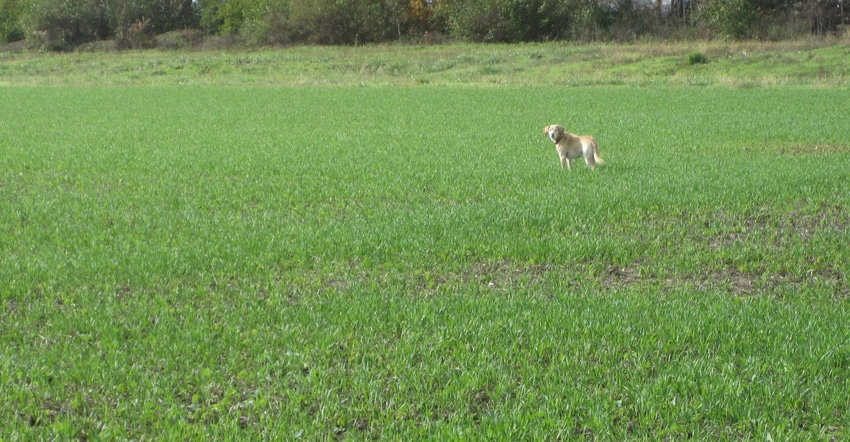
Many farmers scout their corn and soybeans. How many of you scout cover crops while they’re growing in the field? Stephanie McLain, state soil health specialist with the Indiana Natural Resources Conservation Service, believes scouting cover crops can provide valuable information.
Information for Salute Soil Health is prepared by Indiana Conservation Partnership personnel and other partners, led by a team from the Natural Resources Conservation Service. They include McLain; Don Donovan and Clint Harrison, district conservationists; Susannah Hinds, grazing lands specialist; Kris Vance, communications specialist; Tony Bailey, state conservation agronomist; and Shannon Zezula, state resource conservationist.
Scouting your cover crops throughout the fall, winter and early spring will provide you with valuable lessons and help you find successes in this addition to your cropping system, McLain says.
Scouting goals
Look for these four key things when scouting cover crops, McLain says.
1. Nodules on legumes. Legumes like clover, hairy vetch or field peas develop a necessary relationship with beneficial bacteria. Together, they have the amazing ability to pull nitrogen out of the air and “fix” it into nodules on the plant root, McLain notes. These nodules feed the growing crop the nitrogen it needs.
In the case of a legume cover crop, the terminated legume will release any fixed nitrogen into the soil, and it will be available for the next growing crop.
While these legumes are seeded in the fall, most of the biomass and nitrogen they produce occurs in the spring. Plant legume cover crops earlier in the fall than grass species to increase winter survivability in many regions, McLain says.
Scouting a legume cover crop includes digging up the plant roots and looking for nodules. Root nodulation is greatest as the plant approaches the bloom stage in the spring. Push a spade into the soil about 6 inches below the plant, and carefully lift the plant from the soil, exposing roots and nodules. If possible, wash the roots in a bucket of water. Slice open nodules; a pink or reddish interior indicates active nitrogen fixation.
Depending on when the legume cover crop is terminated in the spring, resources say anywhere from 70 to 150 pounds of nitrogen may be available for the next growing crop.
Not seeing nodules? Reevaluate cover crop planting and termination dates, and always inoculate legume seed with a correct bacterial inoculant.
2. Beneficial insects. Ground beetles, green lacewings, lady beetles and a myriad of other insects are considered beneficial, McLain says. These insects eat aphids, slugs, black cutworm moths, armyworms, weed seeds and other crop pests.
Scouting for beneficial insects takes time. Pitfall traps need to stay in the field for about two weeks.
The most important thing is knowing what these beneficial insects look like and understanding their life cycles. Use an Integrated Pest Management strategy to minimize harm to beneficial insects.
Anything sprayed to kill bad bugs will also kill good bugs! Ensure that pesticides and seed treatments are only used when needed and in a way to minimize impacts to beneficial insects.
Add diverse year-round habitat around the field. Use crop rotations and cover crops, and disturb the soil less to encourage these insects, McLain says.
3. Earthworms in the soil. Do you see earthworms, middens or holes when you dig? These are nature’s soil mixers, and they’ll readily convert your crop residues and other plant materials into beneficial soil organic matter.
Use a spade to scout for earthworms, and dig a 1-by-1-by-1-foot hole. Place all the soil from this hole on a tarp or in a container to keep it separated from the natural soil surface. Look through the soil for earthworms. Look for open earthworm channels and channels filled with castings. A typical agricultural soil has anywhere from 50 to 300 worms per square yard. About 10 earthworms per square foot is generally considered to be a good population in ag soils.
If earthworm counts are low, provide a diverse habitat with crop rotations; include cover crops such as brassicas clovers, which earthworms love; and don’t disturb the soil, McLain says. Tillage directly kills about 25% of an earthworm population. Indirectly, the rest of the population is affected by habitat destruction, loss of residues and decreased soil moisture.
4. Quantity and depth of roots. To scout cover crop root depth, dig a few holes and look at root growth, McLain says. Take note of the depth of roots. Are there any bends or curves in the roots? This could indicate a compacted layer that caused the plant root to grow horizontally until it found a fracture in the soil to grow through.
Are cover crop roots growing through compacted layers? Plants have different root types and rooting tolerances. Use a variety of cover crops to reduce soil compaction, aggregate the soil and increase pore spaces. Disturb the soil less. Remember that the next crop’s roots will take advantage of root channels and pore spaces created by cover crops.
About the Author(s)
You May Also Like




